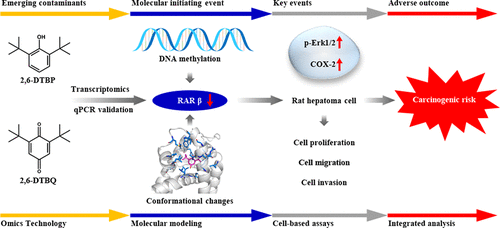当前位置:
X-MOL 学术
›
Environ. Sci. Technol.
›
论文详情
Our official English website, www.x-mol.net, welcomes your
feedback! (Note: you will need to create a separate account there.)
Carcinogenic Risk of 2,6-Di-tert-Butylphenol and Its Quinone Metabolite 2,6-DTBQ Through Their Interruption of RARβ: In Vivo, In Vitro, and In Silico Investigations
Environmental Science & Technology ( IF 10.8 ) Pub Date : 2021-12-19 , DOI: 10.1021/acs.est.1c06866 Shixuan Cui 1 , Yang Yu 2 , Tingjie Zhan 1, 3 , Yuchen Gao 1 , Jiachen Zhang 1 , Liang Zhang 1 , Zhiwei Ge 4 , Weiping Liu 1 , Chunlong Zhang 5 , Shulin Zhuang 1, 3
Environmental Science & Technology ( IF 10.8 ) Pub Date : 2021-12-19 , DOI: 10.1021/acs.est.1c06866 Shixuan Cui 1 , Yang Yu 2 , Tingjie Zhan 1, 3 , Yuchen Gao 1 , Jiachen Zhang 1 , Liang Zhang 1 , Zhiwei Ge 4 , Weiping Liu 1 , Chunlong Zhang 5 , Shulin Zhuang 1, 3
Affiliation

|
Thousands of contaminants are used worldwide and eventually released into the environment, presenting a challenge of health risk assessment. The identification of key toxic pathways and characterization of interactions with target biomacromolecules are essential for health risk assessments. The adverse outcome pathway (AOP) incorporates toxic mechanisms into health risk assessment by emphasizing the relationship among molecular initiating events (MIEs), key events (KEs), and adverse outcome (AO). Herein, we attempted the use of AOP to decipher the toxic effects of 2,6-di-tert-butylphenol (2,6-DTBP) and its para-quinone metabolite 2,6-di-tert-butyl-1,4-benzoquinone (2,6-DTBQ) based on integrated transcriptomics, molecular modeling, and cell-based assays. Through transcriptomics and quantitative real-time PCR validation, we identified retinoic acid receptor β (RARβ) as the key target biomacromolecule. The epigenetic analysis and molecular modeling revealed RARβ interference as one MIE, including DNA methylation and conformational changes. In vitro assays extended subsequent KEs, including altered protein expression of p-Erk1/2 and COX-2, and promoted cancer cell H4IIE proliferation and metastasis. These toxic effects altogether led to carcinogenic risk as the AO of 2,6-DTBP and 2,6-DTBQ, in line with chemical carcinogenesis identified from transcriptome profiling. Overall, our simplified AOP network of 2,6-DTBP and 2,6-DTBQ facilitates relevant health risk assessment.
中文翻译:

2,6-二叔丁基苯酚及其醌代谢物 2,6-DTBQ 通过中断 RARβ 的致癌风险:体内、体外和计算机研究
数以千计的污染物在全球范围内使用并最终释放到环境中,对健康风险评估提出了挑战。关键毒性途径的识别和与目标生物大分子相互作用的表征对于健康风险评估至关重要。不良结果通路 (AOP) 通过强调分子起始事件 (MIE)、关键事件 (KE) 和不良结果 (AO) 之间的关系,将毒性机制纳入健康风险评估。在这里,我们尝试使用 AOP 来破译 2,6-二叔丁基苯酚 (2,6-DTBP) 及其对醌代谢物 2,6-二叔丁基苯酚的毒性作用。-丁基-1,4-苯醌 (2,6-DTBQ) 基于集成转录组学、分子建模和基于细胞的测定。通过转录组学和定量实时 PCR 验证,我们确定视黄酸受体 β (RARβ) 是关键目标生物大分子。表观遗传分析和分子模型显示 RARβ 干扰是一种 MIE,包括 DNA 甲基化和构象变化。体外检测扩展了随后的 KE,包括改变了 p-Erk1/2 和 COX-2 的蛋白质表达,并促进了癌细胞 H4IIE 的增殖和转移。这些毒性作用完全导致致癌风险,因为 2,6-DTBP 和 2,6-DTBQ 的 AO 与转录组分析确定的化学致癌作用一致。总体而言,我们简化的 2,6-DTBP 和 2,6-DTBQ AOP 网络有助于进行相关的健康风险评估。
更新日期:2022-01-04
中文翻译:

2,6-二叔丁基苯酚及其醌代谢物 2,6-DTBQ 通过中断 RARβ 的致癌风险:体内、体外和计算机研究
数以千计的污染物在全球范围内使用并最终释放到环境中,对健康风险评估提出了挑战。关键毒性途径的识别和与目标生物大分子相互作用的表征对于健康风险评估至关重要。不良结果通路 (AOP) 通过强调分子起始事件 (MIE)、关键事件 (KE) 和不良结果 (AO) 之间的关系,将毒性机制纳入健康风险评估。在这里,我们尝试使用 AOP 来破译 2,6-二叔丁基苯酚 (2,6-DTBP) 及其对醌代谢物 2,6-二叔丁基苯酚的毒性作用。-丁基-1,4-苯醌 (2,6-DTBQ) 基于集成转录组学、分子建模和基于细胞的测定。通过转录组学和定量实时 PCR 验证,我们确定视黄酸受体 β (RARβ) 是关键目标生物大分子。表观遗传分析和分子模型显示 RARβ 干扰是一种 MIE,包括 DNA 甲基化和构象变化。体外检测扩展了随后的 KE,包括改变了 p-Erk1/2 和 COX-2 的蛋白质表达,并促进了癌细胞 H4IIE 的增殖和转移。这些毒性作用完全导致致癌风险,因为 2,6-DTBP 和 2,6-DTBQ 的 AO 与转录组分析确定的化学致癌作用一致。总体而言,我们简化的 2,6-DTBP 和 2,6-DTBQ AOP 网络有助于进行相关的健康风险评估。































 京公网安备 11010802027423号
京公网安备 11010802027423号